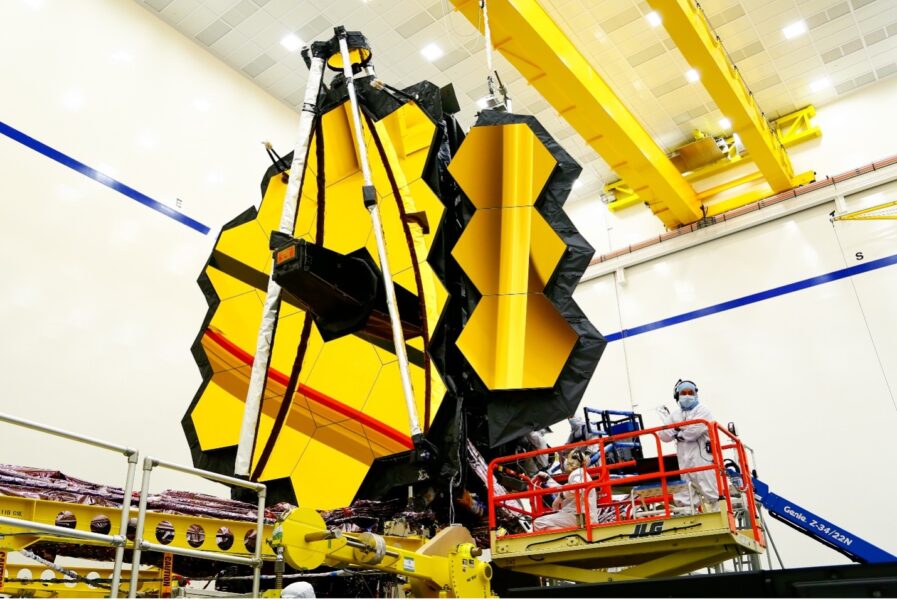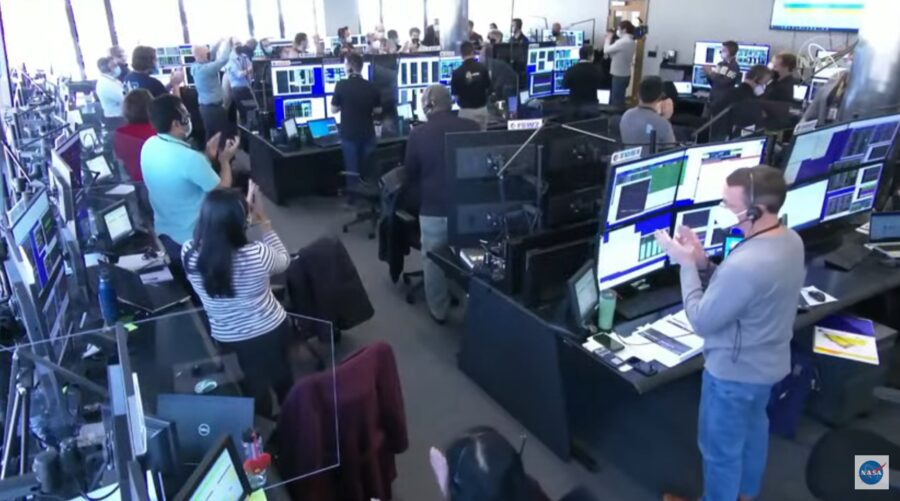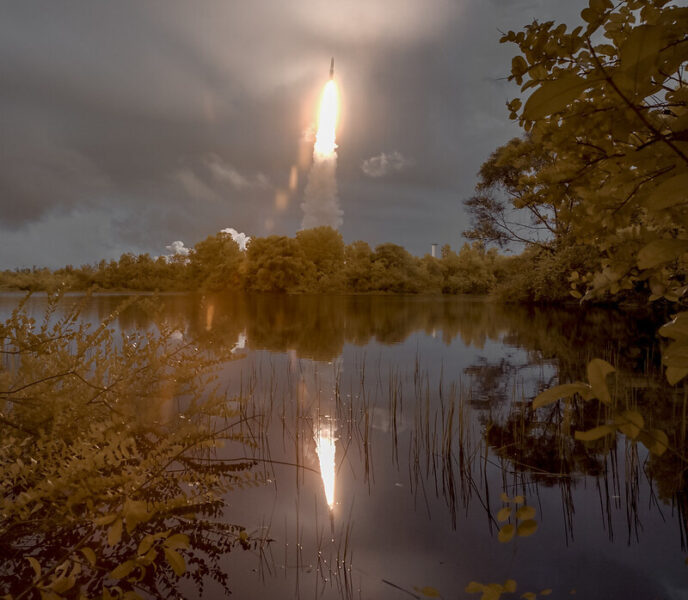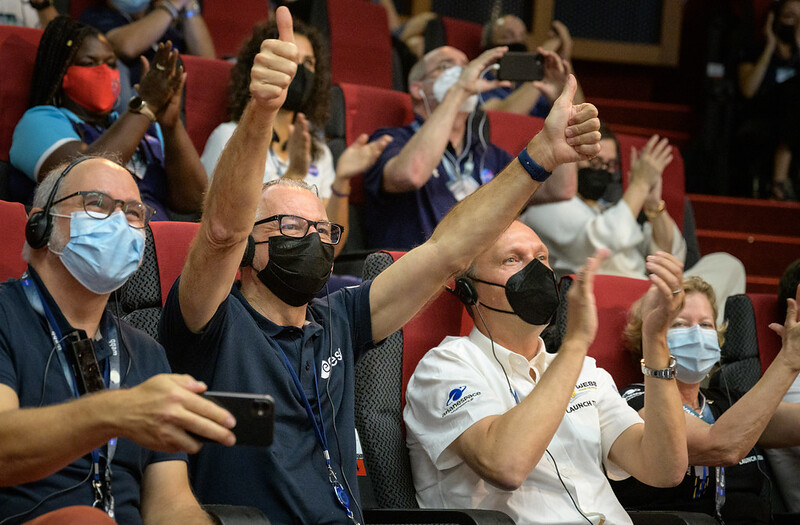The James Webb Space Telescope has unfolded its primary mirror, marking the end of the deployment phase for the observatory.

Northrop Grumann
Just over two weeks into the mission and the origami-like James Webb Space Telescope (JWST) has unfolded just as expected. NASA controllers announced today at 19:17 UT/1:17 p.m. EST that the telescope's final primary mirror segment had locked into place, marking the end of the deployment phase for the space telescope.

NASA TV
"Today, NASA achieved another engineering milestone decades in the making," says Bill Nelson (NASA Adminstrator) in a recent press release. "While the journey is not complete, I join the Webb team in breathing a little easier and imagining the future breakthroughs bound to inspire the world."
#NASAWebb is fully deployed! 🎉
With the successful deployment & latching of our last mirror wing, that's:
50 major deployments, complete.
178 pins, released.
20+ years of work, realized.Next to #UnfoldTheUniverse: traveling out to our orbital destination of Lagrange point 2! pic.twitter.com/mDfmlaszzV
— NASA Webb Telescope (@NASAWebb) January 8, 2022
The Story Thus Far
JWST launched on an Ariane 5 rocket from the Guiana Space Center on December 25, 2021. The last couple weeks have seen the telescope's separation from the second stage, the unfolding and tensioning of its sunshield, and myriad other steps to full deployment.
The observatory sports a 6.5-meter (21.6-foot) primary mirror and a sunshield the size of a tennis court, all of which had to fold up to fit inside the 4.57 meter-wide Ariane 5 rocket fairing before carefully unfolding in space after launch.
The size also meant that there wasn’t a vacuum chamber on Earth large enough to test the telescope in its fully unfurled configuration; instead, engineers are carefully watching how the telescope reacts to the super-cold, zero-g environment of space as it deploys, and adjusting the deployment phase accordingly.

NASA / Bill Ingalls
Recent Deployments for JWST
On January 5th, the Contamination Control Cover for ESA’s Mid-Infrared Instrument (MIRI) was unlocked. This cover protected MIRI from ice contamination during and after launch, in lieu of traditional heater units. The telescope's secondary mirror also deployed on January 5th. This mirror sits on a 7-meter long boom, and had to lock in place to a tolerance of less than 1.5 millimeters, all in micro-gravity and at extremely cold temps. The secondary mirror itself is 0.74-meters (29 inches) across, just slightly smaller than Spitzer’s 33-inch primary (James Webb is a big 'scope!). The heat radiator (the Aft Deployable Instrument Radiator, ADIR) was successfully deployed on January 6th.

NASA / Bill Ingalls
The deployment of JWST's 18-segment primary mirror occurred over January 7th and 8th, marking the end of the deployment phase. The primary essentially has three panels: a central portion and two "wings," which are now folded out and locked in position.
Why aren’t there cameras on Webb? While it certainly would have been interesting to see the actual unfolding process in action, as some have commented on social media, the mission team ultimately decided against including cameras due to the complexity they would have added to an already way over-budget, $11 billion mission. Any cameras would have had to be encapsulated and specially designed to work in ultra-cold and dark conditions, all without adding heat into a system that needs to stay extremely cold. Additional wiring harnesses and hardware, running along more moving joints and potential points of failure, would also have been required.
Over the next few days, JWST will shift its 18 individual mirror segments out of their launch configuration, using six actuators attached to the back of each segment. Then, around January 23rd, 29 days post-launch, thrusters will fire to put the telescope into a halo orbit around the Sun-Earth L2 point, 1.5 kilometers (1 million miles) from Earth. After a five-month phase in which the telescope cools to below 50K (-370°F), tweaking mirror alignment to bring images into focus, and instruments are calibrated, science operations will begin in mid-2022.
JWST is expected to push forward the boundaries of modern astronomy, catching galaxies and stars in the act of formation in the early universe, characterizing the chemical composition of exoplanet atmospheres, and much more.
JWST is now unfolded, healthy, and on its way to its new home around L2.

Gianluca Masi/Virtual Telescope Project
Astronomer Gianluca Masi and the Virtual Telescope Project will provide a live view of the JWST starting tonight at 21:30 UT/4:30 PM EST.
 4
4









Comments
PGT
January 9, 2022 at 5:33 pm
JWST is "on its way to its new home around L2 . . . ."
Will S&T provide info on how to see it from a ground telescope once it gets there?
You must be logged in to post a comment.
Edu
January 10, 2022 at 12:45 am
S&T sure should.
You must be logged in to post a comment.
Monica Young
January 10, 2022 at 10:07 am
The visibility of JWST is an interesting question. Its sunshield reflects sunlight with a strong specular component, so even out at L2 it should still be visible to ground-based telescopes. That said, it might take some time to understand how much and when its brightness will spike.
You can find visibility information on Heavens-Above.com. You can start here: https://www.heavens-above.com/PassSummary.aspx?satid=50463&lat=0&lng=0&loc=Unspecified&alt=0&tz=UCT&showall=t (but note that you'll need to specify your location).
You must be logged in to post a comment.
Edu
January 11, 2022 at 5:20 pm
Excellent. Thanks.
You must be logged in to post a comment.
You must be logged in to post a comment.